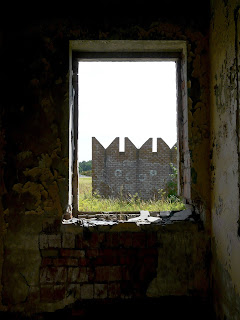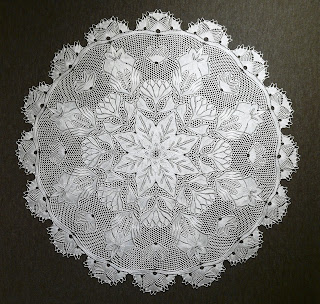After a lovely morning in Haapsalu we headed to an abandoned Soviet airbase - Kiltsi
Officially it is closed, and one is supposed to check in the the Estonian military before entering! We simply left a detailed note with our rental car parked outside the gate. Mostly to avoid the expense of the phone call...
There is a good reason for such caution, the buildings are the finest in Soviet architecture (i.e. they were thrown up quickly with sub-par materials.) Thus, the occasional collapse makes this a slightly risky venture.
Look at that lovely map! The good ol' CCCP...
The offices and barracks in this building may have once been rather nice, the remains of patterned wallpaper and floor tiles remained.
The entire area had been well graffitied, and the site of some drunken benders (judging by the garbage left behind.) We were far from the first to poke around in these abandoned spaces.
A hobbit hole? No! These are large bunkers, for 50s-60s era fighter planes. The bumps are intended to both camouflage and protect the planes within. However, since Estonia is about as hilly as Kansas they had to make artificial bumps which would be rather obvious. Not to mention the miles of runway...
From the back of each bunker extended a small mechanics room which exited into the forest which had sprung up on the untilled land.
Many such spaces appeared to have been the temporary homes of folks with heavy drinking habits.
Ammunition bunkers, a few hundred yards from the plane bunkers. These were conceivably more hidden, but still connected by a net of obvious roads.
Nature was doing a good job of taking back her space, growing up and over the man-made structures.
There was a profusion of herbs and fruits, and I did pick some. However, the Soviets notably dumped large quantities of chemicals while pulling out to prevent their use by other parties. I wouldn't source too much of my diet from this potentially tainted ground until it's had a few more years to clear out. Nature is good at that.
The bunkers were situated in semi-circles, with four in each set. There were dozens of sets and we had only time to explore two or three.
It turns out that we were not the only ones ignoring the closure. As we walked around there were several people driving the old runways, and it appears that impromptu drag races and rallies were held here. Several spots had spray painted marks for driving tracks.
It was, in fact, a rather lovely afternoon. The sun and breeze was pleasant, the birds and bees had returned to the area. Alas, although the sun appears to be high noon in this shot it was in fact late afternoon, and we had driving to do!
Oh look! Just when you thought you were off the base, here's a machine gun position to wave good-bye.
More post to come, we are almost the entire way thru Estonia! Then, it's back to Finland for the final leg of our trip. (We are already planning a trip for this year, whew...)
Saturday, January 30, 2016
Thursday, January 28, 2016
Ace of Lace - Rockstar Knitting
While in Tallinn we naturally found a good bar, one with a long beer list. (We are always wanting to try new beers wherever we go, and Estonia had a remarkably thriving brewing scene!) The waitress saw me knitting, and fetched a small post card. "My friend, he owns clubs, and he knits. You should go see his knitting."
Now, I am a lover of the fiber arts, and will vehemently defend their title as ARTS as well as crafts. But I was a bit surprised, a gallery of knitting? Not a museum with traditional patterns and ethnographic pieces?
We found the building (13th c. and still looking good!), and wound up narrow steps to the gallery space. What should meet my eyes but huge round mandalas of lace - Niebling Shawls pinned out on black velvet.
And what, pray tell, is a Niebling? In knitting circles the name is fairly well known, they are challenging patterns and represent a considerable investment of time and yarn. The man (yes, a man!) behind the patterns is less well known.
Herbert R. Niebling (1903-1966) was a German textile designer with an interest in mathematics. The round shawls he is best known for are excellent examples of mathematical growth structures. Each section is knit in the round with a set number of repeats, then a row or two are knit with a considerable number of increases, and the next section will either have 2-4 times the number of repeats, or a repeated pattern that is 2x-4x larger. Thus, sections grow and expand organically.
The variety of motifs is impressive, from common lace leaf patterns to detailed realistic shapes and geometric designs. Many of the motifs can be found in older knitting patterns, and represent a number of ethnographic sources, but some may have been invented by Niebling himself. That is, however impossible to know, as patterns were rarely written down, and the exact date of an object can be difficult to judge!
Which is the other neat thing about Niebling, he created a system of charting stitches that is now almost universal. One could, without speaking a word of German, pick up an old pattern and knit it, assuming one has been trained in modern knitting charts (or has Google.)
I have seen a number of Niebling shawls in person, both on the needles and on the back. Even knit in very small yarn and needles they tend to be large and impressive textiles! With a heavier yarn and appropriate gauge of needle the doilies become massive bed covers.
However, this exhibit was perhaps the finest lace work I've ever seen. These pieces are much easier to appreciate when blocked wide and seen clearly against a backdrop. Even the non-crafting Mr. Crafty was impressed by the images and designs.
And the second artistry of these is the blocking! Not only were they perfect circles with each point carefully stretched and pinned, but the sway and flow of stitches was carefully arranged. The leaves and flowers tilted carefully, while the in-between stitches were stretched or compressed to allow the entire piece to lay perfectly flat.
I'm going to take a brief moment to remind you, gentle reader, that both the master pattern maker and the skilled knitter here are not your grandmother. In fact, they are both men. So if anyone gives you any bullshit about knitting being a strictly feminine pastime, after you're done lecturing them about medieval knitting guilds, push their face in this and tell them to *redacted*
The pieces ranged from large mandalas, about 4 ft. across, to smaller doilies perhaps only 1 ft. wide.
Here we see the beginnings of a shawl, in fine estonian wool, with wine corks as stitch savers. I mentioned that this guy owned a rock club, right?
A very worthwhile experience in Tallinn! Get a beer at Hopster and then run over and drop a few euros on this gallery, it's well worth it! Even if you're not a stitching enthusiast.
Now, I am a lover of the fiber arts, and will vehemently defend their title as ARTS as well as crafts. But I was a bit surprised, a gallery of knitting? Not a museum with traditional patterns and ethnographic pieces?
We found the building (13th c. and still looking good!), and wound up narrow steps to the gallery space. What should meet my eyes but huge round mandalas of lace - Niebling Shawls pinned out on black velvet.
And what, pray tell, is a Niebling? In knitting circles the name is fairly well known, they are challenging patterns and represent a considerable investment of time and yarn. The man (yes, a man!) behind the patterns is less well known.
The variety of motifs is impressive, from common lace leaf patterns to detailed realistic shapes and geometric designs. Many of the motifs can be found in older knitting patterns, and represent a number of ethnographic sources, but some may have been invented by Niebling himself. That is, however impossible to know, as patterns were rarely written down, and the exact date of an object can be difficult to judge!
I have seen a number of Niebling shawls in person, both on the needles and on the back. Even knit in very small yarn and needles they tend to be large and impressive textiles! With a heavier yarn and appropriate gauge of needle the doilies become massive bed covers.
However, this exhibit was perhaps the finest lace work I've ever seen. These pieces are much easier to appreciate when blocked wide and seen clearly against a backdrop. Even the non-crafting Mr. Crafty was impressed by the images and designs.
And the second artistry of these is the blocking! Not only were they perfect circles with each point carefully stretched and pinned, but the sway and flow of stitches was carefully arranged. The leaves and flowers tilted carefully, while the in-between stitches were stretched or compressed to allow the entire piece to lay perfectly flat.
I'm going to take a brief moment to remind you, gentle reader, that both the master pattern maker and the skilled knitter here are not your grandmother. In fact, they are both men. So if anyone gives you any bullshit about knitting being a strictly feminine pastime, after you're done lecturing them about medieval knitting guilds, push their face in this and tell them to *redacted*
The pieces ranged from large mandalas, about 4 ft. across, to smaller doilies perhaps only 1 ft. wide.
Here we see the beginnings of a shawl, in fine estonian wool, with wine corks as stitch savers. I mentioned that this guy owned a rock club, right?
A very worthwhile experience in Tallinn! Get a beer at Hopster and then run over and drop a few euros on this gallery, it's well worth it! Even if you're not a stitching enthusiast.
Thursday, January 21, 2016
Haapsalu Estonia - Castle by the Sea
It had seemed to us, while in Estonia, that every hill of any vantage had a castle tower on it! We rode into the seaside resort town of Haapsalu on a very different sort of tourism (a site for a future post!) but found the charming town was much to our liking!
Right in the center, looking out on the old town center from above, is an old bishopric and cathedral. Wandering through the extensive grounds are a variety of walls and buildings, of various ages, and in differing states of repair.The main building hosts a small restaurant, medieval games, and a museum. Artisan shops with folk doing demos are also available, but time restrained us.
From old defensive positions - to a modern stage! The sprawling grounds are a considerable tourist attraction, with good reason.
Old moat ditches, from this wall one could look down on the town, and out to sea!
You think this is my last post about a random old castle ruins? It's not! Hooray for traveling...
Subscribe to:
Posts (Atom)




















































